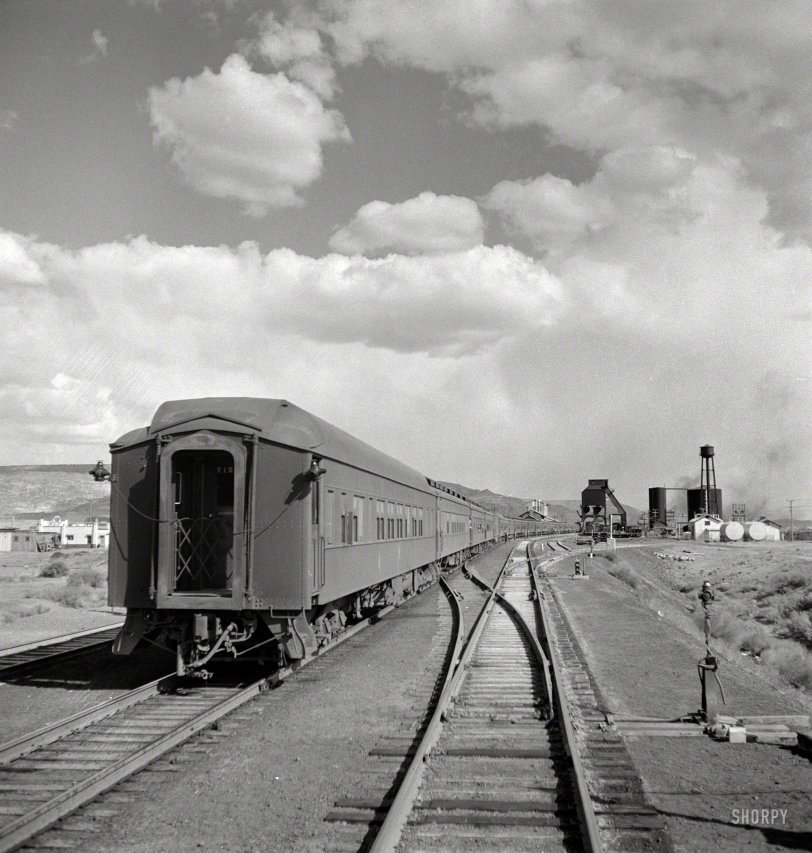


Framed or unframed, desk size to sofa size, printed by us in Arizona and Alabama since 2007. Explore now.
Shorpy is funded by you. Patreon contributors get an ad-free experience.
Learn more.

- Baldwin 62303
- Baldwin VO-1000
- Cold
- No expense spared
- Tough Guys
- Lost in Toyland
- And without gloves
- If I were a blindfolded time traveler
- Smoke Consumer Also Cooks
- Oh that stove!
- Possibly still there?
- What?!?
- $100 Reward
- Freeze Frame
- Texas Flyer wanted
- Just a Year Too Soon
- WWII -- Replacing men with women at the railroad crossing.
- Yes, Icing
- You kids drive me nuts!
- NOT An Easy Job
- I wonder
- Just add window boxes
- Icing Platform?
- Indiana Harbor Belt abides
- Freezing haze
- Corrections (for those who care)
- C&NW at Nelson
- Fallen Flags
- A dangerous job made worse
- Water Stop
Print Emporium
Troop Train: 1943

March 1943. "Grants, New Mexico. Passing a troop train stopping for coal and water on the Atchison, Topeka & Santa Fe between Belen and Gallup." Photo by Jack Delano for the Office of War Information. View full size.
Hell on Wheels
By all historical accounts, Troop Trains were hell on wheels for the soldiers inside them. The trains were typically packed to the gills with soldiers, and more often than not lacked air conditioning. Railroads pressed their older heavy-weight and light-weight stock into service for the soldiers, while the more modern streamlined rolling stock was used for passengers. To add insult to injury, so to speak, soldiers were flat out forbidden from leaving the trains until they reached their final destination.
One account comes to mind, when FDR's son (while en route to a troop transport) and his train came to a stop outside Toccoa Georgia, while on the Central of Georgia Railway. The train needed to stop for a crew change, as well as to refill the water tank on the tender, and take on coal. What's more, the train had to wait for a following passenger train to overtake it. (Troop trains were considered "second class" trains, with passengers being "first class.") Toccoa's history museum recounts testimony from citizens that the train sat in the sweltering Georgia heat for close to three hours while the locomotive was serviced, and the passenger train overtook it. During that time, armed guards at the doors prevented anyone from leaving, or getting aboard. The soldiers themselves traded what little money they had to passengers out the windows, for sundry items like coca-colas, and water. This however was discouraged, with guards often shooing away the civilians.
The civilians proved smarter than the guards might have expected, with groups taking up positions on either side of the train, so while one group might be run off, the second group continued on business as usual. Eventually, the guards themselves simply gave up, and allowed the trading to continue.
Long & grubby!
I tried to count the number of cars, but I got to about 20 and gave up. That's a lot of train! I can't tell, but these might be mostly "heavy-weight" cars with 6 wheel trucks. I wonder, if they were double headed with 2 steam locomotives on the head end?
These passenger cars were kept busy. There would have been a lot troops going in both directions; east to the European Theater and west to the Pacific Theater. I would imagine the cars arrived, were quickly cleaned and turned around with another load of military personnel in the other direction. Just about all troops and materiel moved by rail in WWII. Thanks to Jack Delano for another great railroad photo!
























On Shorpy:
Today’s Top 5